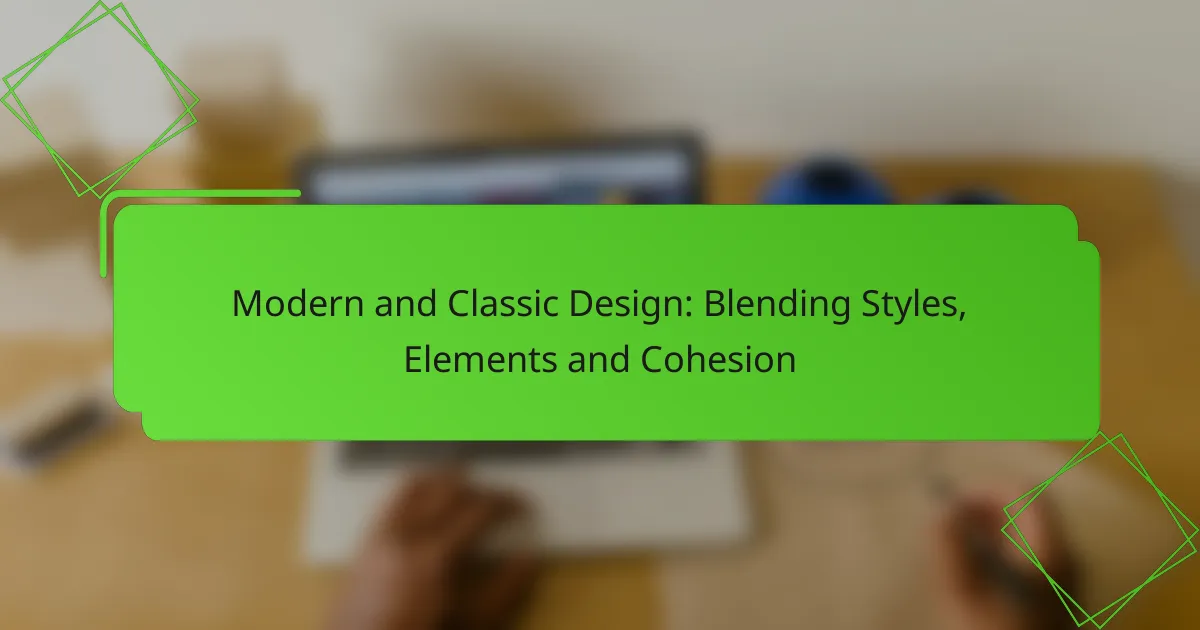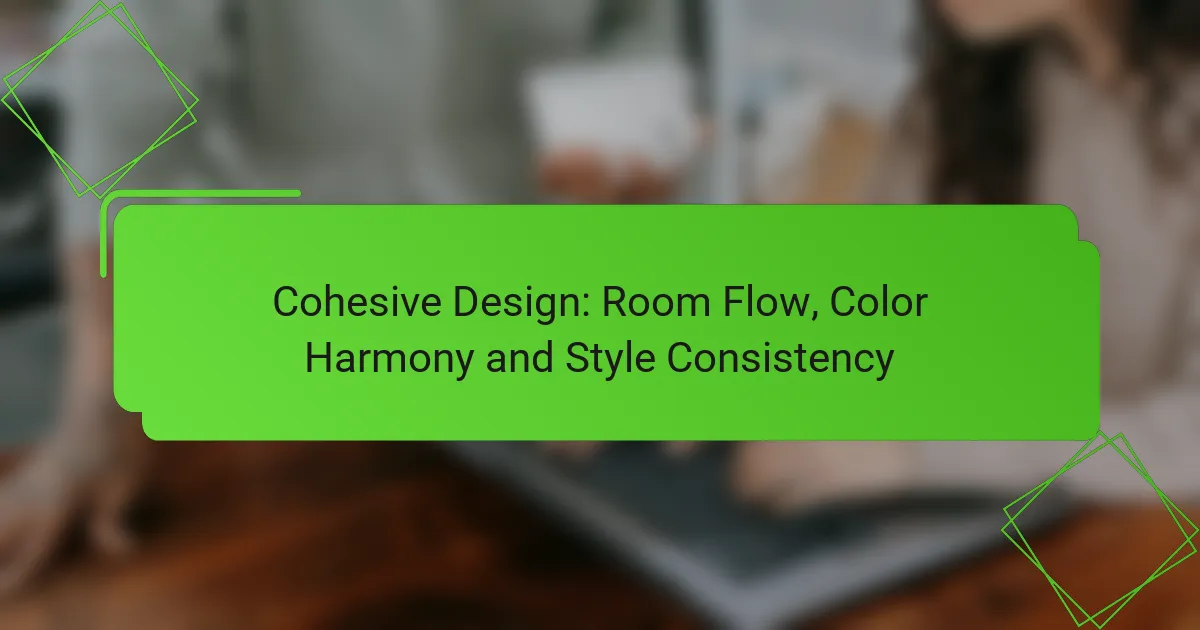Blending modern and classic design creates a harmonious environment that celebrates both innovation and tradition. By integrating contemporary elements like minimalism and technology with timeless aesthetics such as ornate details and rich color schemes, spaces can achieve a unique cohesion that reflects the best of both worlds. This approach not only enhances functionality but also invites a sense of history and elegance into the home.
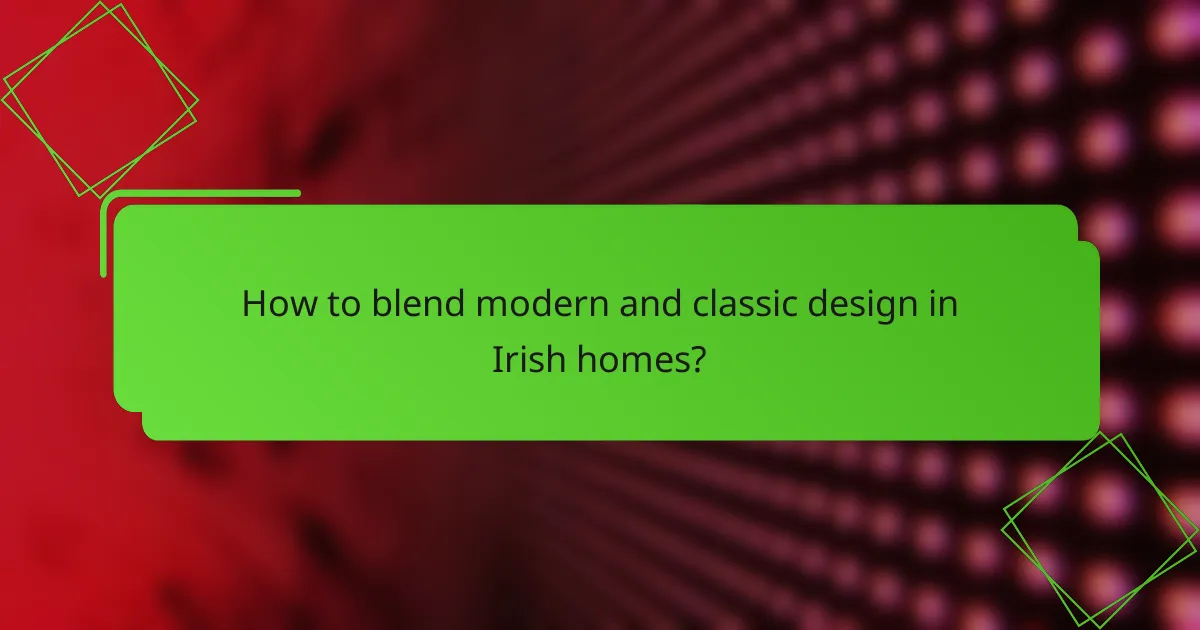
How to blend modern and classic design in Irish homes?
Blending modern and classic design in Irish homes involves harmonizing contemporary elements with traditional aesthetics. This approach creates a unique and inviting atmosphere that reflects both history and innovation.
Use contrasting materials
Incorporating contrasting materials is essential for achieving a balanced blend of modern and classic design. For instance, pairing sleek metals or glass with warm woods or stone can create visual interest and depth. Consider using polished concrete floors alongside reclaimed timber beams to highlight the contrast.
When selecting materials, aim for a mix that complements both styles. For example, a modern kitchen with stainless steel appliances can be softened by classic wooden cabinetry, creating a cohesive yet dynamic space.
Incorporate vintage furniture
Vintage furniture serves as a bridge between modern and classic design, adding character and charm. Look for pieces like mid-century chairs or antique tables that can be integrated into contemporary settings. These items not only provide a focal point but also tell a story.
Incorporate vintage finds in strategic locations, such as a classic armchair in a modern living room or a traditional sideboard in a sleek dining area. This mix enhances the overall aesthetic while maintaining functionality.
Mix color palettes
A well-thought-out color palette can unify modern and classic elements in a home. Consider using neutral tones as a base, then add pops of color through accessories or accent walls. For example, a soft gray backdrop can be complemented by vibrant cushions or artwork.
When mixing colors, aim for a harmonious balance. Pair classic deep blues or greens with modern pastels or bold hues to create a visually appealing contrast that enhances both styles.
Utilize architectural features
Architectural features play a significant role in blending modern and classic designs. Retaining original elements like crown molding or fireplace mantels can add historical depth to a contemporary space. Highlight these features with modern lighting or furniture to create a striking contrast.
Consider open floor plans that incorporate traditional elements, such as archways or exposed brick, alongside modern finishes. This approach maintains the home’s character while embracing a fresh, airy feel.
Focus on functional layouts
A functional layout is crucial for successfully blending modern and classic design. Prioritize open spaces that allow for easy movement and interaction, while still accommodating traditional furnishings. This balance ensures that the home remains practical and inviting.
When designing layouts, consider how different areas will be used. For example, a modern kitchen can seamlessly flow into a classic dining area, creating a cohesive space for entertaining. Avoid overcrowding with furniture to maintain a sense of openness and clarity.

What are the key elements of modern design?
Modern design is characterized by a focus on functionality, simplicity, and a seamless integration of technology. Key elements include minimalism, open spaces, and the innovative use of materials and technology to create a cohesive aesthetic.
Simplicity and minimalism
Simplicity and minimalism are foundational principles of modern design, emphasizing clean lines and uncluttered spaces. This approach often involves using a limited color palette and reducing decorative elements to highlight the beauty of form and function.
To achieve a minimalist look, consider using essential furniture pieces that serve multiple purposes. For example, a sleek coffee table can double as storage, and built-in shelving can reduce visual clutter while providing functionality.
Use of technology
The use of technology in modern design enhances both aesthetics and functionality. Smart home devices, energy-efficient appliances, and advanced materials can create a more comfortable and efficient living environment.
Incorporating technology can be as simple as integrating smart lighting systems that adjust based on natural light or using sustainable materials that improve energy efficiency. It’s essential to stay updated on the latest innovations to ensure your design remains contemporary.
Open spaces
Open spaces are a hallmark of modern design, promoting a sense of freedom and connectivity within a home or office. This layout often involves removing walls to create fluid transitions between different areas, enhancing natural light and airflow.
When designing open spaces, consider the flow of movement and how different areas interact. Use furniture arrangements to define zones without obstructing sightlines, and incorporate large windows or glass doors to maximize light and create a feeling of openness.
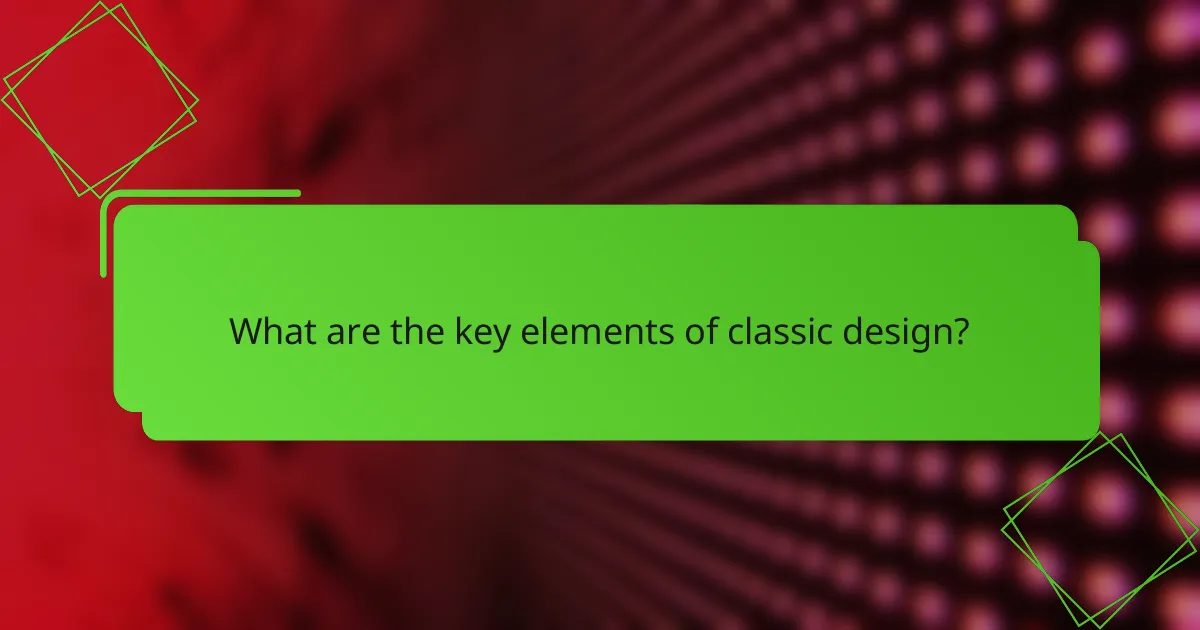
What are the key elements of classic design?
Classic design is characterized by timeless aesthetics, emphasizing elegance and tradition. Key elements include ornate details, rich color schemes, and the use of traditional materials, all contributing to a cohesive and sophisticated look.
Ornate details
Ornate details are a hallmark of classic design, often featuring intricate patterns, carvings, and embellishments. These elements can be found in furniture, moldings, and architectural features, adding a sense of grandeur and sophistication.
When incorporating ornate details, consider the balance between complexity and simplicity. Too many intricate features can overwhelm a space, while well-placed accents can enhance its elegance.
Rich color schemes
Rich color schemes in classic design typically include deep, saturated hues such as burgundy, navy, and forest green. These colors evoke a sense of warmth and luxury, often paired with neutral tones to create balance.
When selecting colors, aim for a harmonious palette that reflects the overall theme of the space. Consider using bold colors for focal points, while keeping larger areas in softer shades to maintain cohesion.
Traditional materials
Traditional materials play a crucial role in classic design, with wood, marble, and brass being prominent choices. These materials not only offer durability but also contribute to the timeless quality of the design.
When choosing materials, prioritize quality and craftsmanship. For instance, solid wood furniture tends to outlast particle board alternatives, ensuring your classic design remains intact for years to come.

What are the benefits of blending styles?
Blending styles in design combines elements from both modern and classic aesthetics, resulting in unique and functional spaces. This approach enhances visual appeal, personalizes environments, and can even increase property value.
Enhanced aesthetic appeal
Combining modern and classic design elements creates a visually striking environment that captures attention. For instance, pairing sleek, contemporary furniture with ornate, vintage decor can create a dynamic contrast that enhances the overall look of a room.
To achieve this, consider using a neutral color palette as a base, then introduce bold accent pieces from different styles. This method allows for a cohesive yet diverse aesthetic that appeals to a wide range of tastes.
Personalized living spaces
Blending styles allows homeowners to express their individuality through their decor choices. By mixing modern and classic elements, you can create a space that reflects personal history and contemporary preferences, making it truly unique.
For example, incorporating family heirlooms alongside modern art can tell a story and evoke nostalgia while maintaining a fresh look. This personalization fosters a deeper connection to the space, making it more enjoyable to live in.
Increased property value
Homes that successfully blend styles often attract a broader market, potentially increasing property value. A well-executed mix of modern and classic elements can appeal to diverse buyers who appreciate both aesthetics.
When considering renovations, focus on high-quality materials and timeless designs that stand the test of time. Investing in features like a modern kitchen with classic cabinetry or a contemporary bathroom with vintage fixtures can yield significant returns in the real estate market.
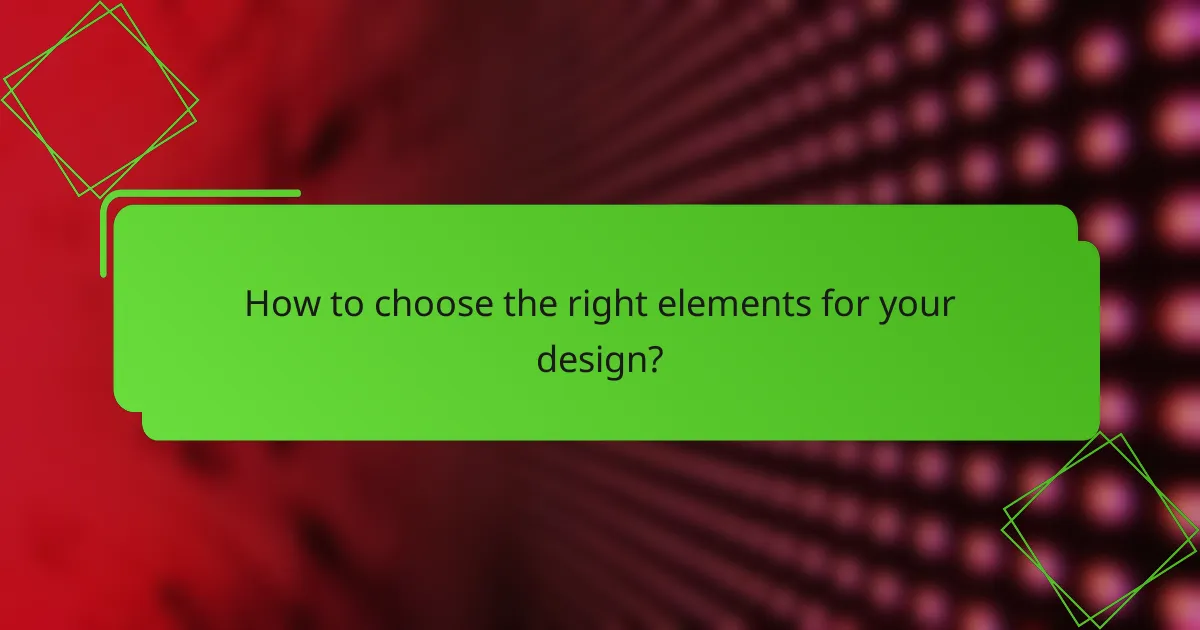
How to choose the right elements for your design?
Choosing the right elements for your design involves understanding your aesthetic preferences, the functionality of the space, and the existing architectural features. By carefully selecting elements that harmonize with these factors, you can create a cohesive and visually appealing environment.
Assess your personal style
Your personal style is the foundation of your design choices. Consider what resonates with you—whether it’s minimalist, rustic, industrial, or a blend of styles. Look for inspiration in magazines, online platforms, or even your wardrobe to identify patterns and colors that you are drawn to.
Once you have a clearer picture of your style, create a mood board. This can include images, color swatches, and materials that reflect your preferences. This visual guide will help you stay focused when selecting design elements.
Consider the space’s function
The function of a space significantly influences the elements you choose. For instance, a living room should promote comfort and social interaction, while a home office requires a more organized and focused atmosphere. Identify how you intend to use the space and select elements that support these activities.
Think about practical aspects such as furniture layout, lighting, and storage. For example, in a small apartment, multifunctional furniture can maximize space efficiency. Ensure that your design choices enhance the usability of the area rather than hinder it.
Evaluate existing architecture
Existing architectural features can guide your design choices and help maintain cohesion. Take note of elements such as moldings, window styles, and flooring materials. These aspects can inform your color palette and the types of furnishings you select.
For example, if your space has classic crown molding, you might want to incorporate traditional furniture styles or color schemes that complement this feature. Conversely, if the architecture is modern, sleek lines and contemporary materials may be more appropriate. Aim for a balance that respects the original structure while allowing for personal expression.
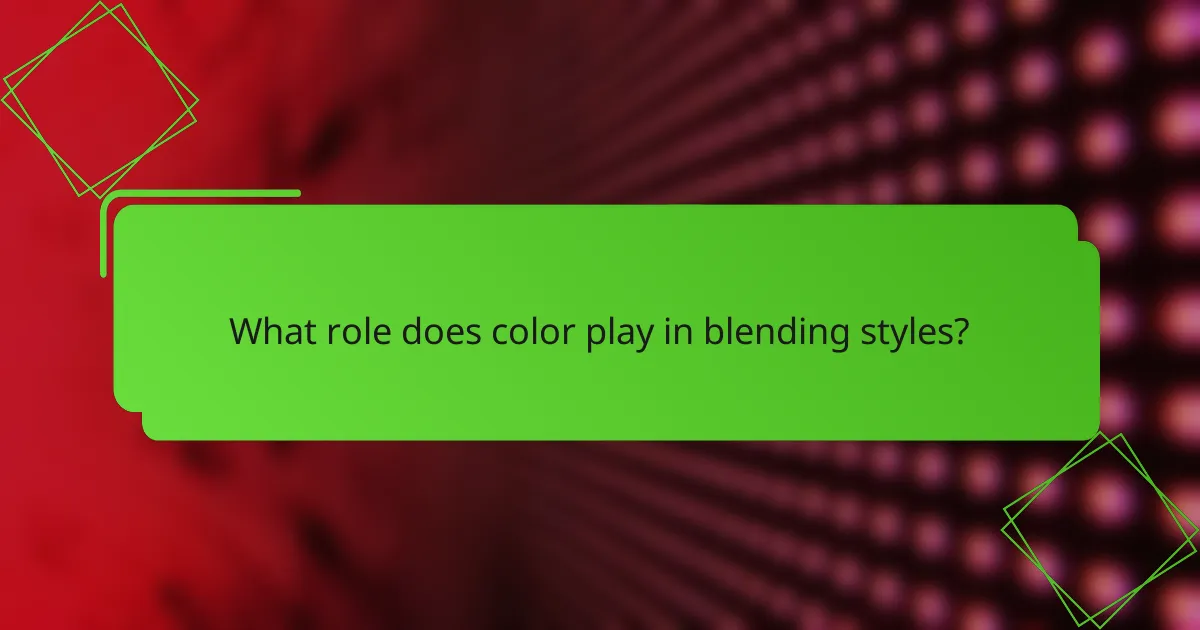
What role does color play in blending styles?
Color is a crucial element in blending modern and classic design styles, as it can unify disparate elements and create a harmonious look. By carefully selecting a color palette, designers can enhance the visual appeal and cohesion of a space, making it feel intentional and well-curated.
Creates visual cohesion
Color creates visual cohesion by linking various design elements together, allowing them to coexist without clashing. When choosing colors, consider a limited palette that incorporates both modern and classic tones, such as muted earth tones paired with vibrant accents. This strategy helps establish a consistent theme throughout the space.
For instance, using a classic navy blue alongside a modern pastel can create a striking yet balanced look. Aim for a mix of warm and cool tones to maintain interest while ensuring that the overall aesthetic remains cohesive. A good rule of thumb is to use no more than three main colors to avoid overwhelming the design.
Additionally, consider the emotional impact of colors. Warm colors like reds and oranges can evoke energy, while cool colors like blues and greens promote calmness. Understanding these effects can guide your choices, ensuring that the blended styles not only look good but also feel right for the intended space.
